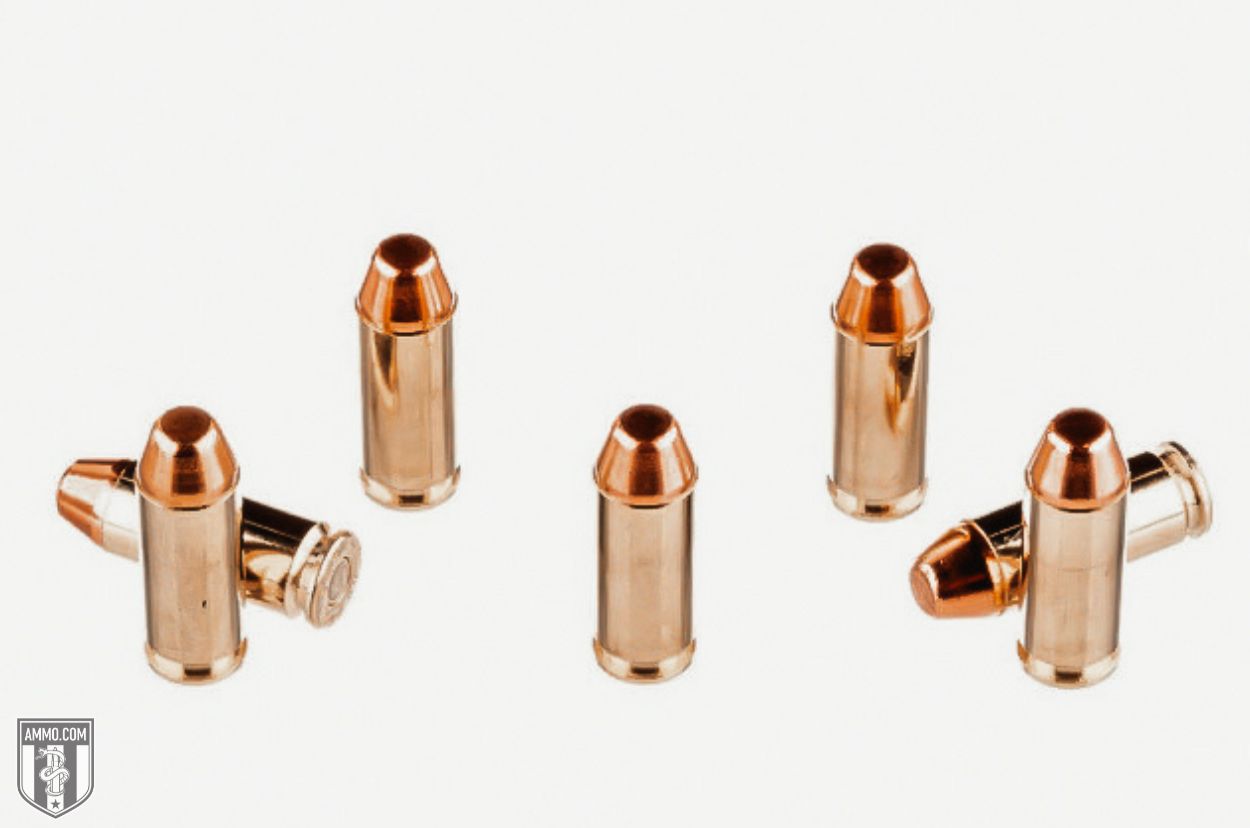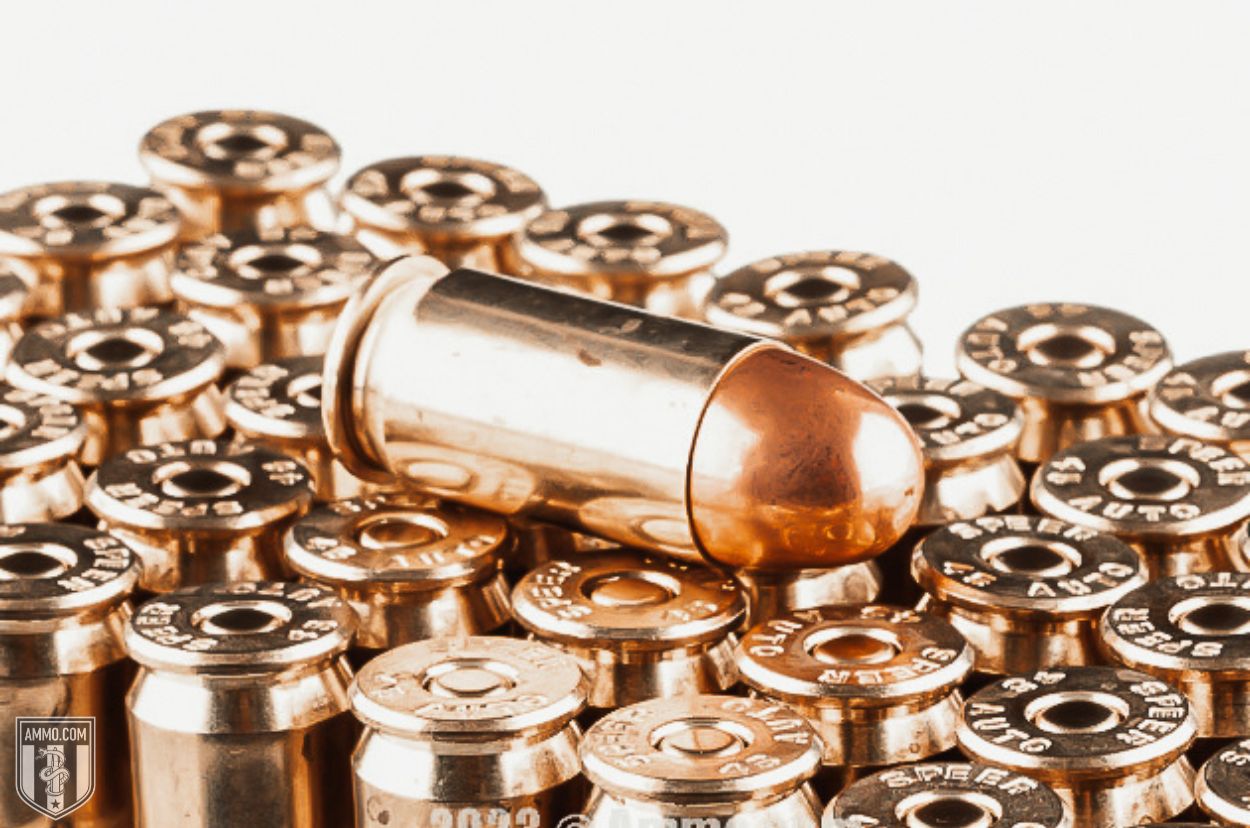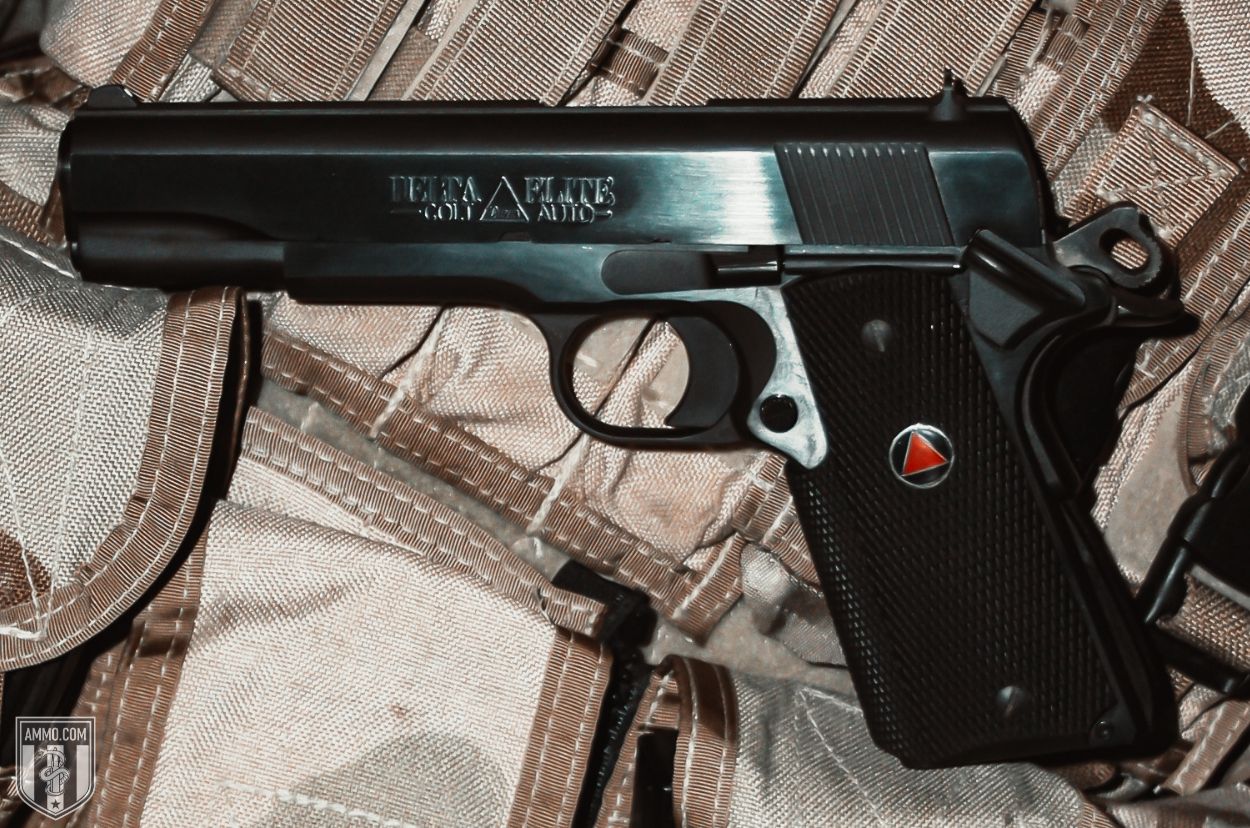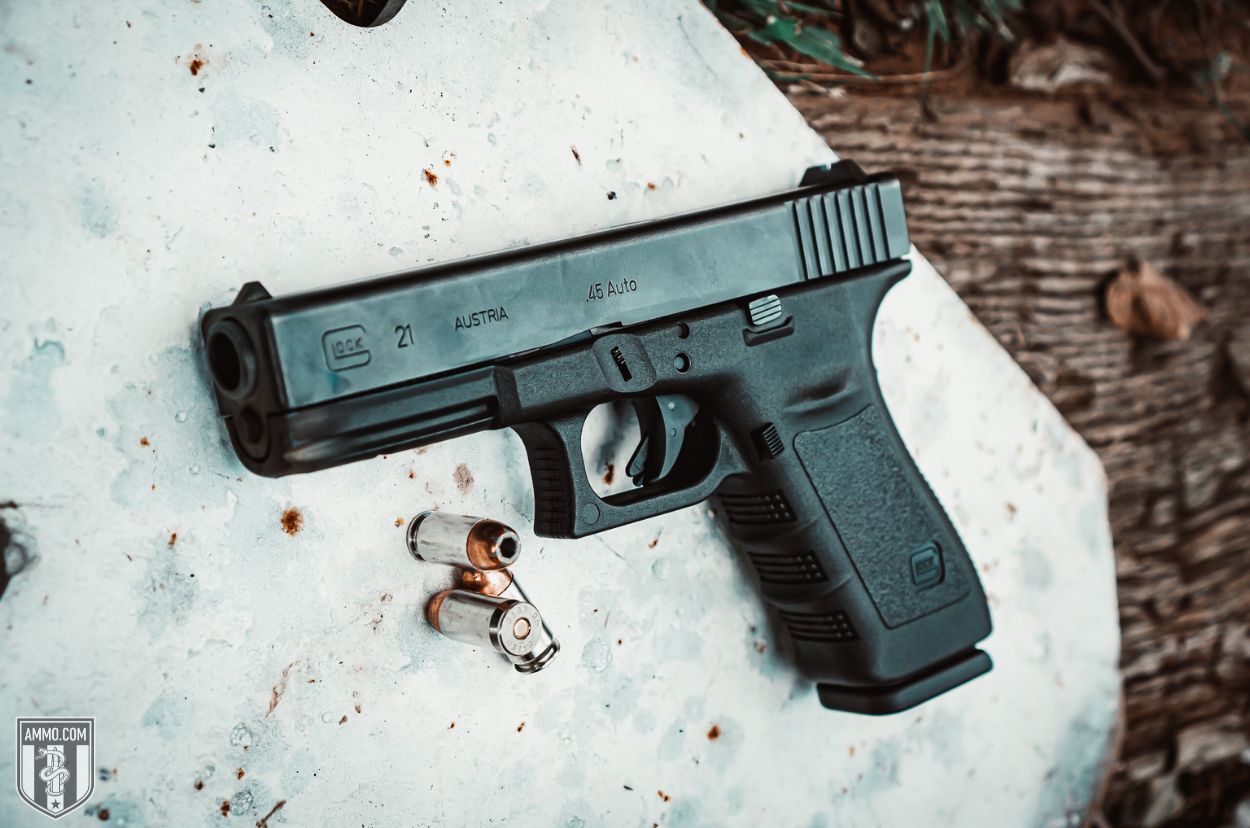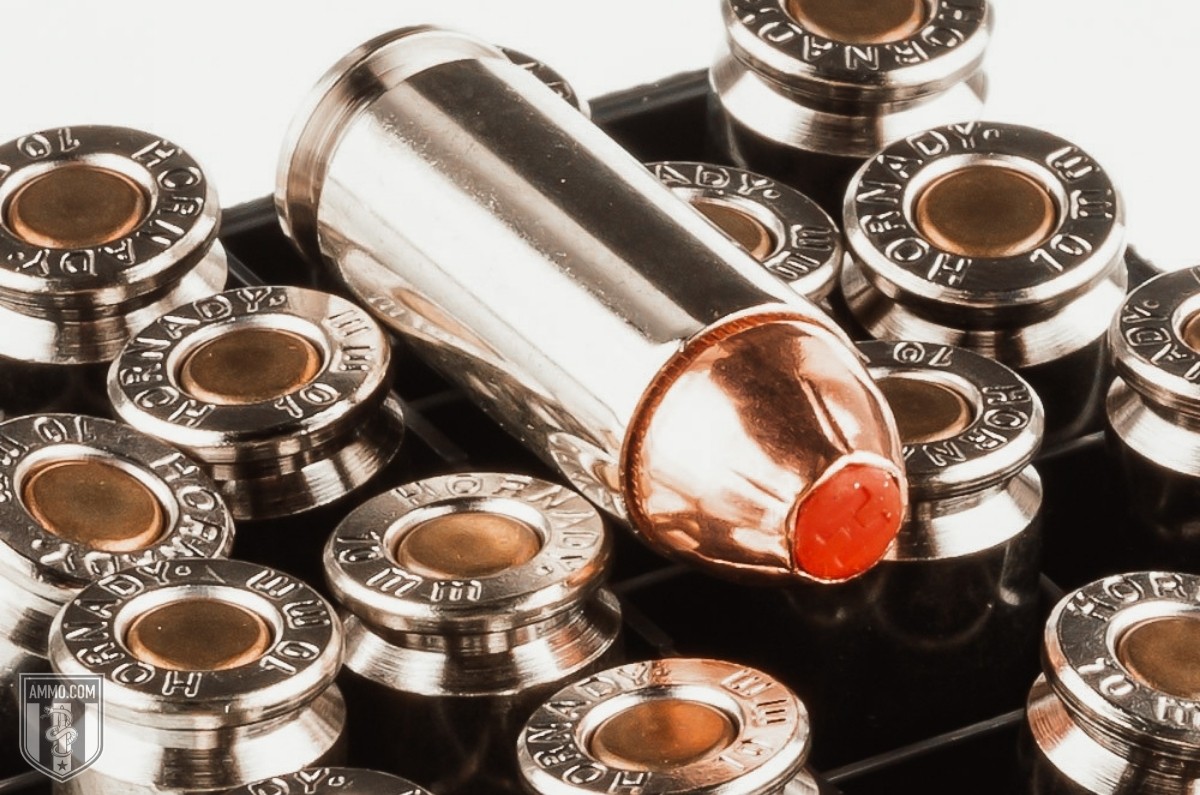10mm vs .45 ACP: Old Reliable or New and Undeniable?
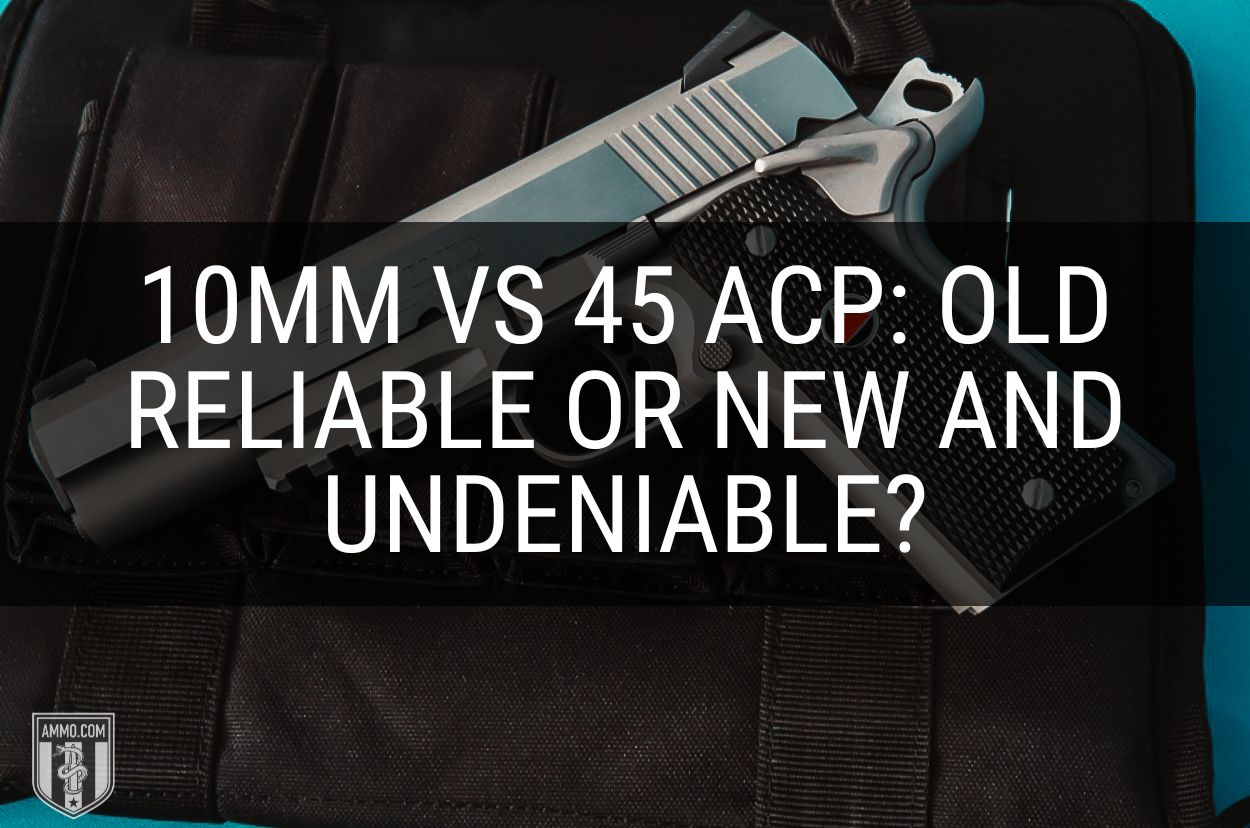 Ff
Ff
People love to debate whether the 10mm is better or worse than most other handgun calibers, including the .45 ACP. Perhaps, this is because the 10mm is the newer kid on the block, and the .45 ACP is a two-time World War champ with a lot of nostalgia and patriotic pride.
The 10mm was created by Lt. Col. Jeff Cooper to be more lethal than the 9mm and surpass the 45 ACP in terms of external ballistics. But does the 10mm accomplish this or is it simply a hotter 40 S&W?
There’s now doubt that each cartridge has its own strengths and weaknesses, but which one is right for you?. This is the real question I’ll help you answer in this article so you’ll have a better understanding if a Glock 21 or a Colt Delta Elite is in your future.
10mm vs. .45 ACP Caliber Comparison
The 10mm vs. 45 ACP debate is one of the more hotly discussed topics among the gun community today. But is the 10mm better than two-time World War champion? Or, is it just a nice alternative cartridge?
Naturally, the caliber you choose is subjective. However, they both have advantages over one another in certain situations. So, unfortunately, it’s nearly impossible to tell you which caliber is superior because I prefer both for different reasons.
Whether your dream handgun is a Glock 20 or a classic Colt 1911, I’ve included all the comparisons you need to know about in the following sections.
Cartridge Specs
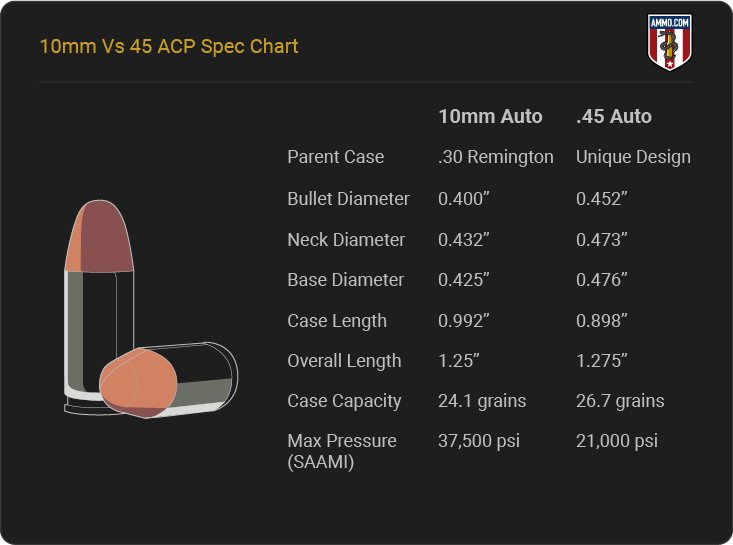
Comparing the specifications of these two handgun calibers really helps to clarify the differences between them. Although there are some similarities, clearly the most substantial difference is the maximum pressure. As you can see in the chart, the 10mm Auto has much more pressure than .45 Auto (37,500 psi vs 21,000 psi, respectively).
While there are some exceptions that I’ll discuss below, the case pressure makes a big difference when it comes to recoil, trajectory, and even practical applications like home defense and hunting (or critter defense, depending on how adventurous you are).
The overall length and diameter of the cases are quite different as well. While the 10mm case is longer, the 45 ACP case is larger in diameter due to the bullet diameter each cartridge fires. Essentially, the .45 ACP cartridge is slightly longer, but the 10mm has more case pressure, and the 10mm has higher muzzle energy and velocity.
Recoil
Recoil plays a large role in choosing a handgun. We all want more energy and faster bullets, but with that comes recoil. Ultimately, the quick answer is that 10mm Auto has higher muzzle velocity and, therefore, more recoil.
On average, a 230-grain 45 ACP round has 7.5 ft-lbs (foot-pounds) of felt recoil, while a 180-grain 10mm load has 11.4 ft-lbs. That means the 10mm has over 50% more recoil than the 45 ACP, which is pretty substantial for many shooters. However, there are variables that can increase and decrease recoil in both calibers.
For example, variables like bullet weight, firearm weight, muzzle velocity, and powder charge all affect felt recoil. One example of the variable differences between ammo and felt recoil are Hornady 10mm Auto 155-grain JHP and Underwood .45 Auto 230-grain. Despite the fact that Underwood’s ammo runs hotter and it’s a heavier bullet, the 155-grain bullet has a higher muzzle velocity. Equal force and Newton’s third law being what it is, the 10mm is still going to kick harder.
Furthermore, if we compare Hornady’s 10mm 155-grain JHPs, which have a much higher muzzle velocity to Underwood .45 ACP 230-grain JHP +P (Jacketed Hollow Point with higher pressure), we’re getting a touch more felt recoil out of the .45 ACP.
Of course, the weight of your firearm also affects recoil. If we compare a classic Government size 1911 (5” barrel) to a Colt Officer’s model .45 Auto pistol with a 3.5” barrel, the recoil is considerably different. Furthermore, comparing a Colt Delta Elite 1911 in 10mm to a Gen 4 full-size Glock 20 and the Glock will have more felt recoil for most shooters. The same concept applies to carbine rifles.
If you’re a novice shooter, who doesn’t get to the range often, the .45 ACP is a better choice due to lower recoil. However, both kick harder than popular calibers like the 9mm Luger and .380 ACP. On the other hand, if you’re old school and used to something like the .357 Magnum or .44 Magnum, you’ll feel right at home with the 10mm.
Trajectory
It’s no secret that the 10mm has a flatter trajectory than the 45 ACP. They’re skinnier and faster, while the .45 ACP is a much slower and fatter cartridge. So, your average, run-of-the-mill .45 ACP cartridges aren’t going to have nearly the trajectory of a 10mm Auto.
To further drive home this point, Federal Law Enforcement 230-grain JHPs have 1.4 inches of drop at the 50-yard mark. Federal Personal Defense HST 10mm 200-grain JHP, on the other hand, drops only 0.5 inches at that same difference.
However, we’re talking ammunition here, so there are variants that create exceptions to the rules. If you’re gun-poor and want the trajectory of a 10mm, but all you have is a .45 ACP, you can narrow the trajectory gap with hotter loads. Hotter .45 ACP +P rounds like Speer Gold Dot .45 ACP +P 200-grain JHP drop only .6 inches at fifty yards.
Accuracy
Accuracy is a pretty big deal. Unfortunately, it’s a bit challenging to say which caliber is more accurate because that all depends on you and your firearm.
Naturally, the two calibers I’m talking about in this article are commonly used for personal defense. This typically means that we only need to hit targets within 25 yards or so, making distance a non-issue for many shooters. Fortunately, both calibers perform well in that range.
Things do get a bit tricky when we consider other factors, though.
First, we must consider recoil. Recoil doesn’t directly affect accuracy because the reaction occurs after the bullet has left the chamber and is already on its way to the target. But it does indirectly affect accuracy when we consider flinching and repositioning your firearm.
Finally, your ability to hit a target depends heavily on how comfortable you are with your firearm. I’m talking about shot placement and training. If you can’t make it to the range often, the .45 ACP is going to be a better fit.
The 10mm Auto has higher velocities and lower grain weights, so it has better accuracy at further distances. However, some shooters report that they are more accurate with their 45 ACP and feel more comfortable with it.
Ultimately, you need to go to the range and see which handgun round works best for you to know which one is more accurate in your hands.
10mm vs .45 ACP Stopping Power
There’s a lot of debate regarding the term stopping power, but we commonly understand it to mean stopping a threat. So, for the purposes of this section, that’s what I’m talking about: will your chosen caliber ensure the continuation of your life by stopping a threat quickly and efficiently?
Fortunately, both the 10mm and .45 ACP semi-auto handguns can efficiently deal enough kinetic energy to stop threats. The 10mm has a rough average of 100 ft-lbs more energy at the muzzle than most .45 ACP rounds. But since we aren’t playing a heated game of Call of Duty, there’s a little more to it than just a mathematical calculation.
In fact, I’d argue that the ammo you’re using and shot placement are more important than energy. First, your 15+1 double-stacked magazine isn’t going to do you any good if only 20% of your bullets are coming close to the target. I’d rather have one great hit than 16 mediocre ones. Therefore, choosing the caliber you’re more comfortable with is more important than stopping power/energy.
Ammo selection also plays a pivotal role.
If a lawless individual intent on harming you and your family breaks into your home at 4 am, your Federal American Eagle 10mm 180-grain FMJ isn’t going to be nearly as efficient as Hornady Critical Defense .45 ACP 185-grain FTX JHP, despite the kinetic energy.
It is interesting to note, however, that the Glock 20 (chambered in 10mm Auto) is the most popular semi-auto handgun sold in Alaska for bear protection.
So, if you’re heading into the woods and are concerned about crossing paths with an angry Grizzly, then a 10mm is probably the better choice. However, if you’re only expecting 2-legged varmints to cause you trouble, then the 45 ACP is more than enough.
Hunting
If you’re new to the firearm game, yes. Handguns can be useful for hunting. Now, I personally wouldn’t intentionally take any pistol caliber to the hunting club for deer or elk. But I always carry one for defensive purposes (i.e., if something is hunting me).
The woods in my area are home to three types of threats: mountain lions, black bears, and tweakers. Those of us who spend a lot of time in the wilderness need cartridges that are versatile enough to protect us from all threats. That caliber is, hands down, the 10mm.
If you’ve ever stumbled across mountain lion tracks armed with only a 1911, you’ll quickly understand why so many people in the mountains prefer 10mm (yes, I’m speaking from experience).
Now, the .45 ACP could take down a mountain lion, but I’m going with the most practical option here. The 10mm will typically have a higher magazine capacity than a 45, and I suspect I’ll need to compensate for a greater margin of error in this situation (shot placement is everything with the .45 and four-legged beasts). If you’re like me, we can’t rely on our exquisite marksmanship abilities when staring down a 160-pound cat with fangs and claws, so some of us will need follow-up shots.
Of course, you’ll also want the distance that the 10mm offers. Woodland creatures are much faster than other threats, and you may have less time to react. So, the more distance your bullet can travel, the safer you’ll be.
While both calibers are perfectly capable of stopping ravenous humanoids, it’s the bears and cats that I’m worried about. Therefore, when it comes to hunting, the higher muzzle velocity and energy of the 10mm win this category.
Self-Defense
Some of the best advice I’ve gotten over the years is that the best self-defense handgun is the one you don’t leave at home. I’ve talked to a lot of shooters over the years who tend to go for these large-diameter calibers and don’t feel comfortable enough to carry them. So, my first piece of advice in this caliber comparison is to go with the one you feel more comfortable with.
Now that that’s out of the way, which one is better for self-defense? Well, both with exceptions. The 10mm has more velocity, but it also has more felt recoil, which is a problem for many. However, the .45 ACP is slower but has slightly less recoil and plenty of energy to stop two-legged threats.
Over penetration is also something to consider in a self-defense situation, as the last thing you want to do is hit an innocent bystander. The 10mm will have considerably higher penetration compared to the 45 Auto, thanks to its higher muzzle velocity.
Properly designed hollow point ammunition should mitigate overpenetration, but knowing what is behind your target is something you should be keenly aware of if you carry a 10mm.
Ultimately, determining which is the better caliber for defense is up to the shooter. Both are adequate threat stoppers. But for most of us, the .45 ACP won two World Wars, and it’s a timeless classic with a long history of lethality. So, it’s the winner of this section.
Home Defense
It’s true that there’s a firearm caliber for every occasion. If you ask me, these are great concealed carry options, but neither of these calibers is the perfect home defense solution. Over-penetration is a concern because both calibers can penetrate sheetrock.
However, if you choose the defense round and live by the “know your target and what’s behind it” philosophy, you can reduce the risks. Also, contrary to popular belief, the 10mm doesn’t necessarily pose more of an over-penetration risk than the .45 ACP. Both meet the FBI’s standards at 12-18”.
You can also reduce the risk of over-penetration by picking out good handgun cartridges. These cartridges should expand on impact. It makes the rounds more lethal to the target and reduces the odds of hitting anyone behind it (it’s still a risk, of course).
Finally, if I’m picking up one of the two on my nightstand, I’m going with the .45 ACP. Mostly because it’s subsonic, and that’s helpful in close quarters (Hornady actually makes subsonic XTP handgun cartridges specifically for this reason). I don’t want the loud crack of jacketed lead breaking the sound barrier in a 15x15 insulated room. So, that’s why the .45 ACP wins in the home defense category.
Ammo Cost and Availability
Unlike the other sections I’ve covered, the 45. ACP is the clear winner of this category. 10mm handguns and ammo tend to be in a more niche category compared to the .45 ACP. Therefore, .45 ACP loads are more available and cost-efficient than the 10mm handgun rounds.
Every big manufacturer makes factory-loaded .45 Auto ammunition in a variety of designs, price points, and composites. Plus, it’s easier to stockpile. Unfortunately, for 10mm Auto ammo, it’s a bit more challenging to find in large quantities and comfortable price points. If you’re into handloading, this is a non-issue, of course. Also, if you're looking to purchase in larger quantities, be sure to visit our .45 ACP bulk ammo page to explore a wide range of options.
However, I’d like to point out that cost isn’t everything. There are many of us who will pay more and work harder to find ammo that performs. If an extra dollar per round means you get to come home from the woods safe with a wildly victorious man vs. bear story, then it’s well worth it.
10mm vs. 45 ACP Ballistics
I would be doing a disservice if I didn’t break down the ballistics of each caliber. Take a gander through the following charts to better understand the differences in ballistics. Of course, do keep in mind that these ballistics vary depending on the firearm and ammunition. If you’re using the same Federal ammo in a Glock 20 and a Glock 21, you may have entirely different results.
10mm Ballistics
| 10mm Bullet WEIGHT | Muzzle VELOCITY (fps) | Muzzle ENERGY (ft. lbs.) | Mid-Range TRAJECTORY (in.) | Barrel Length (in.) | |||||
|---|---|---|---|---|---|---|---|---|---|
| Muzzle | 50 yds. | 100 yds. | Muzzle | 50 yds. | 100 yds. | 50 yds. | 100 yds. | ||
| 155 Grain | 1125 | 1046 | 986 | 436 | 377 | 335 | 0.9 | 3.9 | 5" |
| 155 Grain | 1265 | 1118 | 1018 | 551 | 430 | 357 | n/a | n/a | 5" |
| 170 Grain | 1340 | 1165 | 1145 | 680 | 510 | 415 | 0.7 | 3.2 | 5" |
| 175 Grain | 1290 | 1140 | 1035 | 650 | 505 | 420 | 0.7 | 3.3 | 5.5" |
| 180 Grain FBI | 950 | 905 | 865 | 361 | 327 | 299 | 1.5 | 5.4 | 4" |
| 180 Grain | 1030 | 970 | 920 | 425 | 375 | 340 | 1.1 | 4.7 | 5" |
| 180 Grain HV | 1240 | 1124 | 1037 | 618 | 504 | 430 | 0.8 | 3.4 | 5" |
| 200 Grain | 1160 | 1070 | 1010 | 495 | 510 | 430 | 0.9 | 3.8 | 5" |
Note: This information comes from the manufacturer and is for information purposes only. The actual ballistics obtained with your firearm can vary considerably from advertised ballistics. Also, ballistics can vary from lot to lot with the same brand and type load.
45 ACP Ballistics
| 45 Auto (ACP) Bullet WEIGHT | Muzzle VELOCITY (fps) | Muzzle ENERGY (ft. lbs.) | Mid-Range TRAJECTORY (in.) | Barrel Length (in.) | |||||
|---|---|---|---|---|---|---|---|---|---|
| Muzzle | 50 yds. | 100 yds. | Muzzle | 50 yds. | 100 yds. | 50 yds. | 100 yds. | ||
| 150 Grain | 1050 | n/a | n/a | 403 | n/a | n/a | n/a | n/a | n/a |
| 165 Grain | 1030 | 930 | n/a | 385 | 315 | n/a | 1.2 | n/a | 5" |
| 165 Grain Guard Dog | 1140 | 1030 | 950 | 475 | 390 | 335 | n/a | n/a | 5" |
| 185 Grain | 1000 | 940 | 890 | 410 | 360 | 325 | 1.1 | 4.9 | 5" |
| 185 Grain Match | 770 | 705 | 650 | 245 | 204 | 175 | 2 | 8.7 | 5" |
| 200 Grain | 940 | 890 | 840 | 392 | 352 | 312 | 2 | 8.6 | 5" |
| 200 Grain | 975 | 917 | 860 | 421 | 372 | 328 | 1.4 | 5 | 5" |
| 230 Grain | 830 | 800 | 675 | 355 | 325 | 300 | 1.6 | 6.8 | 5" |
| 230 Grain | 880 | 846 | 816 | 396 | 366 | 340 | 1.5 | 6.1 | 5" |
| 165 Grain +P | 1250 | n/a | n/a | 573 | n/a | n/a | n/a | n/a | n/a |
| 185 Grain +P | 1140 | 1040 | 970 | 535 | 445 | 385 | 0.9 | 4 | 5" |
| 200 Grain +P | 1055 | 982 | 925 | 494 | 428 | 380 | n/a | n/a | 5" |
Note: This information comes from the manufacturer and is for information purposes only. The actual ballistics obtained with your firearm can vary considerably from advertised ballistics. Also, ballistics can vary from lot to lot with the same brand and type load.
45 ACP Development/History: The Champ is Here
The darling John Moses Browning gave the world the .45 ACP in 1904. Browning ultimately answered the United States government’s call for a more lethal and practical cartridge, and we’re eternally grateful for it.
The U.S. Army, in the late 1800s and early 1900s, was equipped with the .38 Long-Colt. Unfortunately, we were at war in the Philippines during this time, and the standard-issue Colt M1892 wasn’t efficient enough to effectively stop the Moro Warriors.
The war ended in 1902, but the need for a larger caliber bullet with more stopping power remained. At this time, Browning was already working with Colt when the call came from the U.S. military to create a more sufficient cartridge.
At first, Browning designed a cartridge that would fire a 200-grain bullet at 900 fps. But after Winchester and UMC got involved, the 230-grain FMJ with a muzzle velocity of 850 fps was born.
After several years of testing, the Colt Model 1911 was selected over the Savage Arms sidearm for its superb reliability (Colt had 0 failures during testing, and Savage had 37 failures). This cartridge served the U.S. military well for more than 70 years through two World Wars, Korea and Vietnam.
10mm Auto Development History: Everything the FBI Wanted But Couldn’t Handle
The creation and development of the 10mm began in the early 1980s with a man named Lt. Col. Jeff Cooper. Ultimately, he wanted something with a flatter trajectory to adequately stop threats at longer ranges (makes sense).
Lt. Col. Cooper teamed up with two other experts, Whit Collins and Irving Stone, to create a brand new cartridge. They cut down a 30 Remington case to .992 inches and filled it with a .40 caliber bullet.
Then, Lt. Col. Cooper started looking for manufacturers to help him fulfill his goal of creating a heartier and more desirable big-bore caliber. First, Dornaus & Dixon Enterprises, Inc. jumped on board (with some help from Norma) and manufactured the Bren Ten 10mm Auto (based on the CZ-75). However, there were many issues with the Bren Ten (despite it being Don Johnson’s preferred firearm in Miami Vice), and Colt ultimately saved the day with their 1911 Delta Elite chambered in 10mm.
Despite Colt jumping on board, the 10mm still wasn’t getting enough notoriety. What it needed was a wild shootout between bank robbers and FBI agents. Unfortunately, that occurred on April 11, 1986. After the FBI’s manhunt for two armed and dangerous bank robbers ended in several casualties, the agency re-evaluated its weaponry and ultimately landed on the 10mm.
Unfortunately, the recoil was a bit too much for this three-letter agency’s men in blue, and the .40 S&W (Smith & Wesson) was born. Of course, that’s a tale for another day. The key takeaway here is that the 10mm is an excellent cartridge, but some can’t adequately hit targets due to the recoil.
Parting Shots
Choosing your next semi-automatic handgun is never as easy as “I read one review, and now I’m ready to choose.” There are a lot of factors to consider beyond whether you want a Colt, Sig, or Glock.
The comparison above should help you decide which caliber is best for you. If you’re woodsy, the 10mm is worth the time, effort, money, and recoil. However, if you want something to protect you in populated areas, the .45 ACP is likely the better bet, mainly because it’s easier to find ammunition. If you want to see which .45 ACP and 10mm ammo we have in stock, click HERE.
Ammo Comparisons
- .308 vs 5.56
- 6.5 Creedmoor vs .308
- .300 Blackout vs .308
- .300 Win Mag vs .308
- .243 vs .308
- .308 vs .30-06
- 7mm-08 vs .308
- .270 vs .308
- 7.62x39 vs .308
- .223 vs .308
- .338 Lapua vs .308
- .380 ACP vs 9mm
- .223 vs 5.56
- .300 Blackout vs 5.56
- 9mm vs 45 ACP
- 9mm vs 40 S&W
- .357 SIG vs 9mm
- 10mm vs 9mm
- 9mm vs 9mm Luger
- .243 vs .270
- .300 Win Mag vs .30-06
- .270 vs .30-06
- .40 vs .45
- 38 Special vs 357
- 9mm vs 40 vs 45
- 5.56 vs 7.62x39
- 338 Lapua vs .30-06
- .30-30 vs .30-06
- 300 PRC vs 338 Lapua
- .30-06 vs 7mm
- 300 Win Mag vs 338 Lapua
- 300 PRC vs 300 Win Mag
- 300 WSM vs 300 Win Mag
- 338 Win Mag vs 338 Lapua
- 12 Gauge vs 20 Gauge
- 10mm vs 357 Mag
- .30-30 vs 7.62x39
- 224 Valkyrie vs 22-250
- 17 HMR vs 22 Mag
- 7.62x39 vs .300 Blackout
- 45 ACP vs 45 Auto
- 45-70 vs 30-30
- 300 Blackout vs 223
- 357 Magnum vs 9mm
- 350 Legend vs 300 Blackout
- 224 Valkyrie vs 223
- 45 ACP vs 38 Super
- 6.5 Grendel vs .308
- 17 HMR vs 22 LR
- 10 Gauge vs 12 Gauge
- 22-250 vs 223
- 45 Colt vs 45 ACP
- 350 Legend vs 30-30
- 5.7x28 vs 223
- 5.7 vs 9mm
- 5.56 vs 5.7
- 22 vs 9mm
- Buckshot vs Birdshot
- 450 Bushmaster vs 308
- 450 Bushmaster vs 223
- Buckshot vs Slug
- 6.5 Grendel vs 5.56 vs 223
- 6mm ARC vs 6.5 Grendel
- 44 vs 45
- 458 SOCOM vs 5.56
- 357 vs 44
- 32 ACP vs 380
- 300 Win Mag vs 338 Win Mag vs 338 Lapua Mag
- 450 Bushmaster vs 458 SOCOM vs 50 Beowulf
- 6mm Creedmoor vs 6.5 Creedmoor
- TMJ vs FMJ
- 44 Special Vs 44 Magnum
- 45 90 vs 45 70
- 6.8 Western vs 6.8 SPC
- 50 Beowulf vs 50 BMG
- 26 Nosler vs 6.5 PRC
- 28 Gauge vs 410
- 6.8 SPC vs 5.56
- 6.8 SPC vs 6.5 Grendel
- 6.8 Western vs 7mm Rem Mag vs .28 Nosler
- 6.8 Western vs 6.5 Creedmoor
- 22 Hornet vs 223
- 6.8 Western vs 6.5 PRC
- .410 vs 12 Gauge
- .410 vs 20 Gauge
- 22 LR vs 22 Mag
- 6mm ARC vs 243
- 7mm-08 vs 270
- 243 vs 6.5 Creedmoor
- Nickel vs Brass Casing
- 204 Ruger vs 223
- 50 Beowulf vs 5.56
- 260 Remington vs 6.5 Creedmoor
- 6mm Remington vs 243
- 28 Nosler vs 300 PRC
- 50 Beowulf vs 50 AE
- 22 Nosler vs 22-250
- 450 Marlin vs 45-70
- 300 Win Mag vs 300 Norma
- 458 SOCOM vs 300 Blackout
- 38-55 vs 45-70
- 22 Hornet vs 22 LR
- 300 Norma vs 338 Lapua
- 338 Lapua vs 50 BMG
- 28 Nosler vs 300 Win Mag
- 28 Nosler vs 6.5 Creedmoor
- 204 vs 22-250
- 458 SOCOM vs 45 70
- 44 40 vs 45 70
- 6.8 SPC vs 6.5 Creedmoor
- 450 Bushmaster vs 30-06
- 7mm Rem Mag vs 300 Win Mag
- 30 Carbine vs 223
- 25-06 vs 30-06
- 26 Nosler vs 28 Nosler
- 16ga vs 12ga
- 30 06 vs 7.62 x54R
- 9mm Makarov vs 9mm Luger
- 350 Legend vs 223
- 30 Carbine vs 5.56
- 6.5x55 vs 6.5 Creedmoor
- 6.5 Creedmoor vs 270 vs 25-06
- M193 vs M855
- 450 Bushmaster vs 458 SOCOM
- 6.5 Grendel vs 6.5 Creedmoor
- 350 Legend vs 5.56
- .277 Fury vs 6.8 SPC
- 277 Fury vs 300 Win Mag
- 10mm vs .45 ACP
- 277 Fury vs 223
- 6.8 SPC vs 300 Blackout
- 6.5 PRC vs 6.5 Creedmoor
- 277 Fury vs 308
- 277 Fury vs 6.5 Creedmoor
- 350 Legend vs 450 Bushmaster
- 277 Fury Vs 5.56 NATO
- 10mm vs 40S&W
- 32 ACP vs 9mm
- 32 Special vs 9mm
- 8.6 Blackout vs 300 Blackout
- 30 Super Carry vs. 9mm
- 5.56 vs 9mm
- .50 Action Express vs 9mm
- 7.62x25 vs. 9mm
- 10mm vs 44 Magnum
- 300 Blackout vs 300 Win Mag
- 6.5 Grendel vs 300 Blackout
- 460 Rowland vs 10mm
- 300 RUM vs 300 PRC
- 300 Norma vs 300 PRC
- 45 GAP vs 45 ACP
- 7mm PRC vs 300 Win Mag
- 300 PRC vs 6.5 Creedmoor
- 300 PRC vs 308
- 357 SIG vs 357 Mag
- 7.62x39 vs 7.62x51
- 243 Win vs 223 Rem
- 30 Nosler vs 300 PRC
- 6.5 Creedmoor vs. 30-06 Springfield
- 450 S&W vs. 44 Magnum
- 6.5 Creedmoor vs. 300 Win Mag
- 454 Cassull vs. 45-70 Govt
- 454 Cassull vs. 44 Mag
- 7.62x54r vs. 308 Winchester
- 22 ARC vs. 223 Rem
- Subsonic vs. Supersonic Ammo
